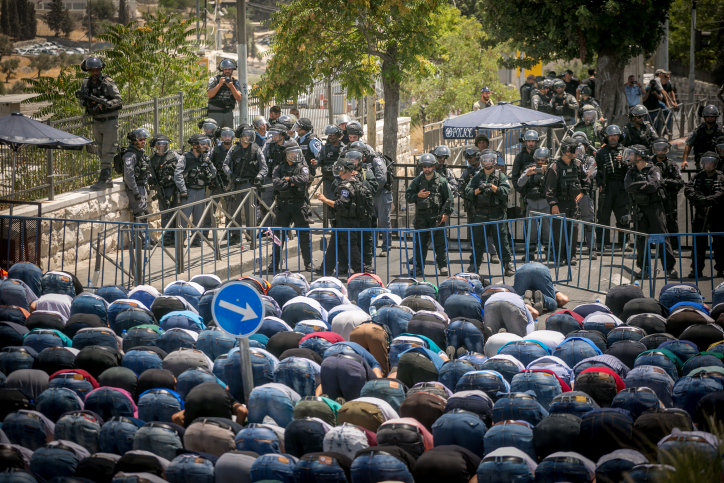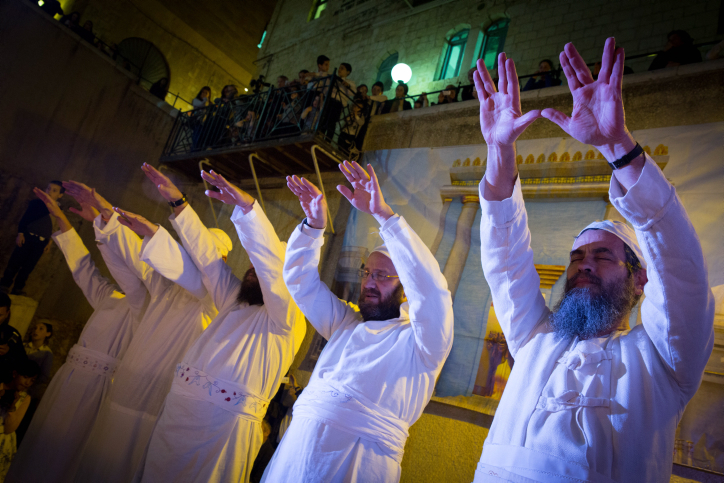While Israel has tried to remove extremist Muslim groups from the Temple Mount, the power of Jewish extremists has only grown. Now the latter are doing all they can to try and change the delicate status quo in their favor.
By Yonathan Mizrachi

In recent weeks tensions have escalated on the Temple Mount/Haram al-Sharif, leading to clashes between Palestinian worshipers and police, a large number of arrests, an Israeli court injunction, and calls for mass protests. An analysis of the latest events, and the history leading up to them, makes clear that the current conflict over Bab al-Rahma is inextricably linked to the Third Temple movements’ goal of building a synagogue on the Mount.
Last month, the Islamic Waqf, the Muslim body responsible for overseeing the Haram al-Sharif/Temple Mount compound, reopened the Bab al-Rahma (Golden Gate) and designated it for Muslim prayer. In theory this should have remained an internal matter for the Waqf, but fierce objections by Jewish Third Temple movements and Israeli politicians rapidly turned the affair into a political issue.
Bab al-Rahma is arguably the most unique of all the Old City gates in Jerusalem. It is the only gate that leads directly onto the Temple Mount/Haram al-Sharif and the only gate that remains blocked to this day. Bab al-Rahma features in the Jewish, Christian, and Islamic traditions. A Muslim cemetery, also called Bab al-Rahma, is situated on its east, and to its west, the gate segues into a split-level compound with a large hall and chambers.
The date of the gate’s construction remains disputed, but we do know from the testimonies of Jewish pilgrims in the 12th century that by then the gate was already sealed. According to one telling, the Muslim cemetery of Bab al-Rahma was already established in the 8th century CE to thwart the Jewish messiah, who according to tradition would use the route to reach the Temple Mount. The gate has remained sealed ever since. Another narrative posits that the gate was closed to protect against Christian invaders.
In Judaism, Bab al-Rahma is said to be the gate through which the messiah will enter Jerusalem. The fact that it is sealed gives credence to the tradition that it will only reopen at the time of redemption. For followers of the Third Temple movement, it has turned it into something of a pilgrimage site. Groups of Jews on pilgrimage to the Temple Mount tend to walk to Bab al-Rahma and demand the establishment a synagogue at the site. To do so, they propose turning existing structures into prayer sites or synagogues, rather than building new structures.
Although traditionally rabbis have forbidden Jews to pray on the Temple Mount, in 1967 Israel established a synagogue at the Madrasa al-Tankiziya (the “Mahkamah” building), a structure from the Mamluk period adjacent to the Chain Gate that juts several meters into the Temple Mount Haram al-Sharif compound. Today, the Mahkamah serves as an Israeli police station, but one of the spaces in the building is used as a synagogue on some Jewish holidays — the only such Jewish prayer space in the area of the Temple Mount/Haram al-Sharif.

In 1999 the Islamic Waqf began to work on underground spaces beneath Al-Aqsa mosque and in the southeast corner of the Temple Mount/Haram a-Sharif compound. These spaces are known as the lower Al-Aqsa mosque and the Al-Marwani mosque (known as “Solomon’s Stables”). Hundreds of tons of earth were removed, causing unprecedented damage to the archaeological strata. The Waqf claimed, even if not officially, that the mosques were established in response to concerns of an Israeli plan to build a synagogue below Al-Aqsa. To this day, concerns that a synagogue and prayer sites will be established at the Temple Mount/Haram a-Sharif, are a repeated source of tension.
The Islamic Waqf may have decided to establish a mosque at Bab al-Rahma as a preventative measure, and doing so seems to have become the go-to reaction when tensions rise between the Third Temple movements and the Islamic Waqf. However, in contrast to the works undertaken in 1999, the Islamic Waqf is weaker today, whereas the Third Temple movements have gained in strength.
Israel has gone to great lengths to remove extremist Muslim groups from the Temple Mount over the years, beginning with the Islamic Movement and more recently the Murabitat groups, outlawing both. On the Jewish side, the extremist groups have only grown stronger. Instead of curtailing their activities, the Israeli government has quite effectively strengthened their presence at the compound.
According to the agreement from which it draws its authority, the Waqf is not allowed to initiate physical changes to the compound. Turning ancient structures into prayer sites, on the other hand, seems to be its only remaining recourse. Doing so makes no difference in terms of the holiness of the mount, since the whole Temple Mount/Haram al-Sharif compound serves as a Muslim prayer site.
In contrast, the Third Temple Movements have an interest in provoking conflict. As far as they are concerned, the recent events at Bab al-Rahma are an opportunity to change the status quo and they are well versed in how to use their political power to pressure the police and government to respond harshly, in the hopes of provoking conflict that might ultimately change the status quo in their favor.
The tensions around Bab al-Rahma are important because they shed light on the real issue underlying tensions at the Temple Mount:it is not a question of sovereignty, but whether it will become a place for Jewish prayer alongside the Muslim prayer. So long as both sides employ arguments that are thousands of years old and religious fervor intensifies, the risk of a conflagration remains high.
The author is an archaeologist and CEO of the organization Emek Shaveh. This article was first published in Hebrew on Local Call. Read it here.
